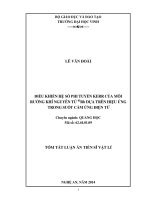Section 3 2 TRƯỜNG ĐIỆN TỪ
Bạn đang xem bản rút gọn của tài liệu. Xem và tải ngay bản đầy đủ của tài liệu tại đây (78.23 KB, 12 trang )
Slide Presentations for ECE 329,
Introduction to Electromagnetic Fields,
to supplement “Elements of Engineering
Electromagnetics, Sixth Edition”
by
Nannapaneni Narayana Rao
Edward C. Jordan Professor of Electrical and Computer Engineering
University of Illinois at Urbana-Champaign, Urbana, Illinois, USA
Distinguished Amrita Professor of Engineering
Amrita Vishwa Vidyapeetham, Coimbatore, Tamil Nadu, India
3.2
Gauss’ Laws and
the Continuity Equation
3.2-3
GAUSS’ LAW FOR THE ELECTRIC FIELD
S D • dS V dv
z
(x, y, z)
x
Dx x x y z Dx x y z
Dy
z x Dy z x
y y
y
Dz z z x y Dz z x y
x y z
z
y
y
x
3.2-4
D
x x x
Dx x y z
Dy
Dy Δ z Δ x
y +Δy
y
Lim
x 0
y 0
z 0
Dz z z Dz z x y
x y z
x y z
Lim
x 0 x y z
y 0
z 0
3.2-5
Dx Dy Dz
x
y
z
Longitudinal derivatives
of the components of D
• D
Divergence of D =
Ex. Given that
0 for – a x a
0 otherwise
Find D everywhere.
3.2-6
• •
• •
• •
• •
•
•
•
•
•
•
•
•
•
•
•
•
•
•
•
•
•
•
•
•
•
•
•
•
•
•
•
0
•
•
•
•
•
•
•
•
•
x=–a x=0 x=a
Noting that = (x) and hence D = D(x), we set
0 and
0, so that
y
z
Dx Dy Dz Dx
• D
x
y
z
x
3.2-7
Thus, • D = gives
Dx
(x)
x
which also means that D has only an xcomponent. Proceeding further, we have
x
Dx – x dx C
where C is the constant of integration.
Evaluating the integral graphically, we have the
following:
3.2-8
–a
0
a
x
x
– ( x ) dx
2 0 a
–a
0
0
a
x
From symmetry considerations, the fields on
the two sides of the charge distribution must
be equal in magnitude and opposite in
direction. Hence,
C = – 0a
3.2-9
Dx
0 a
–a
a
x
– 0a
– 0 a a x
D 0 x a x
0 a a x
for x –a
for – a x a
for x a
3.2-10
GAUSS’ LAW FOR THE MAGNETIC FIELD
D • dS = dv
S
From analogy
V
• D
S B • dS = 0 = V 0
dv
• B 0
• B 0
Solenoidal property of magnetic field lines. Provides test for
physical realizability of a given vector field as a magnetic
field.
3.2-11
LAW OF CONSERVATION OF CHARGE
d dv 0
J
•
dS
S
dt V
• J t ( ) 0
• J t 0
Continuity
Equation
3.2-12
SUMMARY
B
E –
t
D
H J
t
• D
(1)
(2)
(3)
• B 0
(4)
• J
0
t
(5)
(4) is, however, not independent of (1), and (3) can be
derived from (2) with the aid of (5).









